

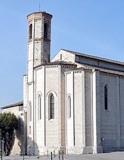
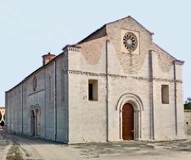
The first Franciscan community in Gubbio settled in a humble hermitage near Santa Maria della Vittoria, the church near which St Francis tamed a wolf as he walked from Assisi to Gubbio in 1206 after he had renounced all of his possessions. He is thought to have stayed with the Spadalunga family, who were wool merchants and who were probably business associates of his father, although their sympathies obviously lay with his disinherited son.
In ca. 1240, the Spadalunga family gave the friars a house and warehouse on the present site within the city walls. In 1259, Pope Alexander IV gave them permission to build the present church and adjoining convent on the site. In 1292, Pope Nicholas IV granted indulgences to those visiting the church in order to provide funds for its completion. Local tradition attributes its construction to Fra Bevignate, although there is no documentary support for this hypothesis.
The community was suppressed in 1866 but was able to return 25 years later.
Exterior
The orientation of the church is unusual in that the apse and left wall face the piazza, while the façade faces onto the less imposing area of Via Ortacci.
The Romanesque portal in the facade is original, but the small rose window (13th century) above it, which came from San Francesco, Foligno, was installed only in 1958. The single mullioned windows that flank the portal were partly closed when the interior of the church was renovated in 1724.
For a period, the main entrance to the church was via the twin portals in the left wall, although one of these doors was closed in the remodelling of 1724. The rose window (14th century) above, which has a relief of the Lamb of God at its centre, is original.
The three octagonal apses belong to the earliest part of the church. The octagonal campanile (15th century) was built above the apse on the right.
Interior

San Francesco is unusual among the churches of Gubbio in that arcades of elegant columns separate the central space into a nave and two aisles. These culminate in the three apses that you saw outside.
According to tradition, the wall nearby in the right aisle and the sacristy behind it were part of the original Spadalunga complex.
The nave and aisles originally had open-trussed roofs, part of which survive in the bays nearest the apse. The vaulting of the aisles dates to the 15th century, while that of the nave dates to the 1724 remodelling.
Main Apse
The frescoes (ca. 1280) in the apse are attributed to the Maestro di San Francesco di Gubbio:
Christ with saints
These frescoes in the upper part of the apse depict Christ blessing with SS Peter, Paul, Francis and Anthony of Padua. The placing of the two Franciscan saints with SS Peter and Paul at this early date is highly significant.
Frescoes on the Pilasters
These frescoes on the pilasters that flank the apse depict:
-
✴on the right:
-
•SS Paul and John the Baptist; and
-
•the Madonna and Child ; and
-
✴on the left:
-
•the mystic marriage of St Catherine of Alexandria:
-
•SS Christopher and Antony Abbot; and
-
•the Pietà.
Right Apse
This apse is in two parts, one above the other.
Upper part
The frescoes (ca. 1280) in the upper part of this apse, which are attributed to the Maestro di San Francesco di Gubbio, depict two scenes from the life of St Francis:
-
✴St Francis renouncing his inheritance; and
-
✴the dream of Pope Innocent III.
They are closely modeled on the same scenes in the nave of the lower church of San Francesco of Assisi.
Lower part
This chapel, which at some point belonged to the Sforzolini family, contains the relics of three beatified Franciscans:
-
✴Bartolomeo da Gubbio (died 1236);
-
✴Tommaso da Gubbio (died 1334); and
-
✴Pietro da Gualdo Tadino (died 1367).
The frescoes (ca. 1320) in the chapel, which are attributed to the Maestro Espressionista di Santa Chiara (Palmerino di Guido?), depict:
-
✴Christ the Redeemer and the Evangelists, in the vaults; and
-
✴six other saints [which ??], on the walls.
Left Apsidal Chapel
The following works in this chapel are attributed to Ottaviano Nelli:
Scenes from the Life of the Virgin (1408-13)
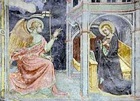
Madonna della Misericordia (15th century)
In 1896, the Madonna’s eyes in this altarpiece were seen to move.
Frescoes (15th century)
These frescoes on the pilaster to the right depict:
-
✴the Mystical Marriage of St Catherine of Alexandria;
-
✴St Christopher;
-
✴St Antony Abbot; and
-
✴the dead Christ with instruments of the Passion.
Altars in the Nave
Madonna and Child with saints (1735-6)
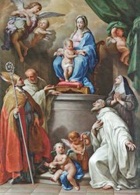
Payments were made for the execution of the Gubbio altarpiece and its transportation from Rome in 1735-6. It is attributed to Francesco Fernandi, called Imperiali, an older associate of Pompeo Girolamo Batoni, and it seems likely that Forte Gabrielli Valletta was associated with its commission. The Franciscan tertiaries who used the altar were probably also involved: documents in the archives of San Francesco refer to it as the altarpiece of the Blessed Castora, who had herself been a Franciscan tertiary. The role, if any, in the commission of the Ranghiasci family, to whom the altar belonged, is unknown.
Madonna and Child with saints (17th century)
This altarpiece, which is signed by Benedetto Bandiera, is on the 2nd altar on the left. It depicts the Madonna and Child with SS Bonaventure, Clare and Charles Borromeo.
St Antony of Padua (1673)
This altarpiece, which is by/attributed to Anna Angelica Allegrini, is on the altar in the 3rd bay on the left. [Signed? Dated by inscription?]
Vision of St Antony of Padua (ca. 1655)
This altarpiece, which is attributed to Francesco Allegrini, is on the altar in the 6th bay on the left.
Immaculate Virgin (1693)
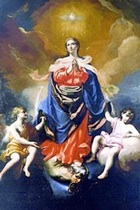
Crucifixion with Franciscan saints (17th century)
This altarpiece by/attributed to Giovanni Battista Michelini, il Folignate is on the 2nd altar on the right. It originally depicted the crucifixion set in a dark landscape with St Antony of Padua kneeling at the foot of the cross and a baby angel. A levitating figure of St Joseph of Copertino was subsequently added, probably at the time of his canonisation in 1767. Giuseppe Reposati was paid in 1776 to improve this figure and to convert the figure of St Antony into that of Bonaventura da Potenza, who had been beatified in the previous year.
Descent from the Cross (1581)
The Arte dei Calzolari (shoemakers’ guild) commissioned this altarpiece from Virgilio Nucci for their altar (in the 6th bay on the right). It is a copy of a work by Daniele da Volterra (17th century) in the church of SS Trinità del Monte, Rome. The frescoes that Virgilio Nucci painted in this chapel at this time no longer survive.)
Franciscan saints (1731 and 1745-7)
These ten saints in oval frames on the counter-facade and between the side altars were painted in two phases:
-
✴some (probably those of St Bonaventure and the Blessed Benvenuto da Gubbio) by Mattia Malatesta 1731; and
-
✴the others by Giuseppe Reposati in 1745-7.
Art from the Church
Tabernacle (14th century)
This tabernacle in the Pinacoteca Civica was discovered in the sacristy in 1910. It was originally probably used for the personal devotions of one of the friars. It is decorated with small works of art of various provenances, together with four small gilded glass reliquaries.
Tabernacle (1529)
This documented tabernacle by Luca and Giacomo Maffei no longer survives.
Immaculate Conception (1584)
This altarpiece from San Francesco, which is attributed to Virgilio Nucci, is now in the deposit of the Pinacoteca Civica.
Franciscan altarpiece (early 17th century)
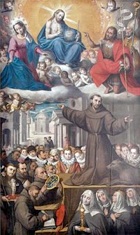
The altarpiece depicts St Francis kneeling beside the docile wolf in what is probably an idealised representation of Piazza Grande. He seems to be preaching to the crowd about the scene above, in which Christ in Judgment is flanked by the Virgin (with a halo of stars that symbolises her Immaculate Conception) and SS John the Baptist and Ubaldus. The stigmata in his right hand and his cord (representing poverty) are prominent. He holds similar cords in his left hand that he presumably intends for those members of his audience who are moved to join the Compagnia del Cordone. A number of Franciscan saints attend the sermon:
-
✴SS Antony of Padua, Bonaventure, Louis of Toulouse, Bernardino of Siena and Louis of France, to the left of the podium; and
-
✴SS Clare and Elizabeth of Hungary with two other Franciscan women below it.
Convent
The door (13th century) in the right wall near the apse leads via the sacristy to Chiostro della Pace (14th century), which houses a display of interesting Roman mosaics (1st – 3rd centuries AD) that have been excavated in the city.
Another lovely portal in the cloister leads to the Sala Capitolare (chapter house), which was built at the same time as the church, although it was reduced in size during the 15th century.
From here you can enter the refectory on the right and then the convent, which houses a small museum known as the Raccolta d’ Arte di San Francesco.
Crucifixion with saints (14th century)
This fresco survives in the cloister.
Santa Casa di Loreto (ca. 1350)
This detached fresco in the chapter house came from the cloister, and is perhaps the earliest representation of the translation of the Madonna’s house to Loreto. It is often cited as evidence for the long history of the tradition of this miraculous translation, which is believed to have occurred in the late 13th century.
Adoration of the Cross (1540)
This altarpiece in the ex-refectory, which is signed by Benedetto Nucci and dated by inscription, was documented in the apse of the church in 1923. It was designed to form the backdrop to a wooden crucifix, and depicts the standing Virgin and St John the Evangelist and the kneeling St Francis.
Madonna and Child with saints (ca. 1600)
This altarpiece, which is attributed to Felice Damiani, came from the Cappella di San Romualdo in San Francesco. It originally depicted the Madonna and Child enthroned with SS Nicholas of Bari, Ubaldus and Romuald. In 1790, this last figure was overpainted by Giuseppe Reposti with a figure of St Francis, who venerates a cross and who is accompanied by the wolf that he pacified in Gubbio. The restoration of the panel in 1998 revealed this over-painting and the arms of the Marioni family, to whom the chapel belonged.

